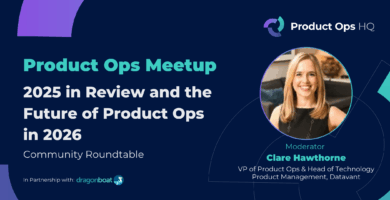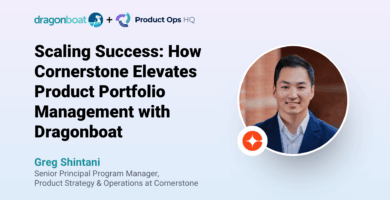Events • On Demand | Watch Time: 10 Min
Why Dragonboat for Product Portfolio Management? Q&A with Chatmeter CPO and PMO
As scaleups grow, product management alone is not enough. Where product management enables innovation and problem solving for customer needs, portfolio management ensures strategic alignment and allocation to maximize portfolio outcomes.
Recently, Dragonboat chatted with the Chatmeter team, including Sridhar Nagarajan, VP of Product and Alex Diallo, Senior Technical Project Manager to see how Chatmeter combines roadmapping and product portfolio management with Dragonboat and how they create an outcome-focused, collaborative culture with better alignment and visibility.
How is Your Roadmapping and Product Management Process?
Alex Diallo: When I joined the company, the engineering team was using Jira for tracking development progress, and the product managers were using another roadmapping tool to share updates with internal stakeholders. However, this setup did not give us enough visibility into resource planning. No one really knew what would happen in terms of timeline if a project switched from one team to another. The visuals were quite decent, but we needed more flexibility and integration with Jira. Of course, we were also using Excel, deep in pivot tables and graphs, which were complex and hard to understand.
So as soon as I started, we were already looking for a better solution. We needed something to connect everything—projects, resources, and business outcomes.
Why Did You Choose Dragonboat for Product Portfolio Management?
Sridhar Nagarajan: We were using another roadmapping tool before, and it was very much a cosmetic tool to communicate the roadmap to key stakeholders.
But after using the simple roadmapping tool for some time, we finally realized that our real goal wasn’t just to have pretty Gantt charts. We wanted a better understanding of the inputs driving the Gantt charts with the ability to close the loop between all the different groups—product teams, dev leaders, operations, and executives.
We needed everyone to connect to the strategy, plan, and outcomes in real-time.
By reconsidering our primary goal, we started asking ourselves better questions. How much do we want to invest in this initiative? How is that investment doing? In addition, we also wanted to manage things like scoring each initiative to help us prioritize our efforts.
Once we have all of these inputs defined, the output, which is the Gantt chart, is relatively straightforward. That’s the easy part.
Alex Diallo: We looked at Jira and other Atlassian third-party tools, but the options were either too complicated or with too much extra noise for our use case. At the end of our projects, most of our data was in Jira but the original estimates and whatnot were on a different platform. So, we really needed to get the data out of Jira and have everything linked together, so we didn’t need to update things in Jira, then update another tool, and so on.
Now with Dragonboat, we have it all in one place and we can see the expected start and end dates, along with the original efforts and estimates. And it’s in real-time, so we can see how we’re making progress in Jira.
It also helps at the end of the quarter to be able to look back and evaluate how we measured up with our timeframe and estimates, and it gives us data and feedback to improve on when moving onto new projects.
Sridhar Nagarajan: Ultimately, we wanted to have a single source of truth for our product initiatives, and Dragonboat has helped bridge that gap. All of our tactical execution happens in Jira, and we do strategic planning in Dragonboat. The bi-directional integration between both tools is super helpful because we can transpose initiatives from Dragonboat into Jira to flow downstream into our sprint planning process.
How Do You Use Dragonboat Today?
Alex Diallo: We have multiple product managers that use the tool not just for the portfolio and roadmapping aspect but also for product backlog management, prioritization, and reporting. We also have our engineering team planning the infrastructure roadmap in Dragonboat. They go in, add their ideas and estimates, and look at the resources.
Other groups use Dragonboat for visibility purposes, like the marketing, sales, and channel partner teams. They’re not constantly entering data, but they look at Dragonboat regularly for updates and documentation needs.
We also make sure to reference Dragonboat during team meetings and within internal documentation, which is a great constant reminder that Dragonboat is our source of truth, and all the information you need is available there.
What Views and Reports Does the Team Look at for Product Planning?
Alex Diallo: We use Dragonboat on a weekly to biweekly basis. The primary view is under the Portfolio section, where we have our initiatives grouped by quarter. Our product managers can easily filter by their own product area and make sure our goals are on track for the quarter. Do we have everything that we need? Do we need estimates from the engineering team?
Another view is under the Dashboard in our Summary view, where we have our product matrix that’s used for the internal product blog. These kinds of views are not only great for product and engineering, but it’s easily accessible to everybody in the company. At any point in time, anyone can look at updates and see if things are on track, so it improves visibility.
We can always check the roadmap and see how our sprints will affect the rest of the month and quarter. And we can look at our backlog for the rest of the year to tackle additional prioritization, estimations, and so on.
Sridhar Nagarajan: Additionally, we do annual high-level planning to identify our areas of focus. Quarterly, we dive into what we need to build. This step includes assigning the work to pods and teams and identifying the touchpoints between these teams. That way, we bake collaborativeness into the planning.
How Does Chatmeter Create Cross-Team Alignment and Visibility?
Sridhar Nagarajan: Chatmeter has built a culture of collaboration. As a company scales, we know that this is usually the first thing to drop off. I bring this up because you need to choose tools that support your culture, not detract from it. A big part of alignment and visibility is how you collaborate cross-functionally.
Simply put, Dragonboat enables our collaborative culture and makes us better.
It enables us to communicate across the board consistently. Not just internally but with customers, the executive team, and our development team. Now everyone is aligned and aware of what’s happening and coming down the pipeline.
How Has Dragonboat Made Your Life Easier?
Sridhar Nagarajan: I now know which teams will be working on what and when. I also know when to pull the teams in without making it burdensome and saying, “you need to write this doc,” or “you need to get it signed off and approved,” and so on.
Everything is in Dragonboat, giving the team visibility and peace of mind.
It enables us to communicate across the board consistently. Not just internally but with customers, the executive team, and our development team. Now everyone is aligned and aware of what’s happening and coming down the pipeline.
Alex Diallo: The whole dynamic. It’s all right there and accessible within a few clicks. As the team is going through sprints, we can easily see if we are ahead of schedule, running behind, or if something changes—it’s all in Dragonboat.
You don’t have to ask me if you want to see the roadmap and any potential updates. Curious about the progress? It’s available. It saves a lot of time and questions and brings visibility to everyone.
Describe Dragonboat in One Word?
Alex Diallo: Visibility. I had a meeting the other day with employees from other departments with requests such as, “I need to know when things are coming up,” – well, perfect, check Dragonboat.
Definitely visibility.

Featured Speakers

Alex Diallo
CPO, Chatmeter

Sridhar Nagarajan
VP of Product Chatmeter
Sridhar Nagarajan is a business and SaaS Product leader with global experience in the e-commerce, payments, and Martech industries, and a track record of delivering delightful products across multiple markets. Sridhar is currently VP Product at Chatmeter, heading up product, design, and analytics, and scaling the team for growth.


